The Critical Firefox Update is a misleading page that displays fake alerts offering install an questionable software. If your browser constantly displays the “Critical Firefox Update” alert then this might be a sign that adware (also known as ‘ad-supported’ software) was installed on your personal computer. The adware is an unwanted software that is going to open you a lot of popup deals advertisements including misleading advertising like these “Critical Firefox Update” fake warnings. Of course, it’s not a malware or virus in the “general meaning” of this word. It will not delete or damage your files, but it can alter some machine’s settings or download and install other harmful software. So, you’d better to get rid of adware using the steps below and thereby delete “Critical Firefox Update” popup.

“Critical Firefox Update” is a fake alert
What is more, the adware which cause misleading “Critical Firefox Update” popup to appear, may show advertisements depend on a web-site that you are visiting. That is, it is clear that this ‘ad supported’ software, without your permission, steals privacy information about you such as: your ip address, what is a web page you are viewing now, what you are looking for on the Net, which links you are clicking, and much, much more. The worst is, the adware may monetize its functionality by collecting personal information from your surfing sessions. This privacy data, afterwards, can be easily transferred third party companies. This puts your privacy information at a security risk.
The adware usually affects only the Google Chrome, Internet Explorer, Mozilla Firefox and Edge by changing the browser’s settings or installing a malicious extensions. Moreover, possible situations, when any other browsers will be hijacked too. The ad-supported software will perform a scan of the computer for internet browser shortcut files and alter them without your permission. When it infects the internet browser shortcuts, it will add the argument such as ‘http://site.address’ into Target property. So, each time you start the web-browser, you will see an unwanted “Critical Firefox Update” site.
We strongly recommend that you perform the step by step tutorial below that will allow you to remove “Critical Firefox Update” popup warnings using the standard features of Windows and some proven free applications.
Remove “Critical Firefox Update” popup (removal guide)
Not all undesired applications like ad-supported software which cause misleading “Critical Firefox Update” pop up to appear are easily uninstallable. You might see popups, deals, text links, in-text advertisements, banners and other type of advertisements in the Google Chrome, IE, Firefox and MS Edge and might not be able to figure out the program responsible for this activity. The reason for this is that many unwanted apps neither appear in MS Windows Control Panel. Therefore in order to completely remove “Critical Firefox Update” fake alerts, you need to complete the following steps. Read this manual carefully, bookmark or print it, because you may need to shut down your browser or reboot your PC system.
To remove Critical Firefox Update, complete the following steps:
- Remove “Critical Firefox Update” pop up scam without any tools
- Run free malware removal utilities to completely get rid of “Critical Firefox Update” fake alerts
- Use AdBlocker to block “Critical Firefox Update” and stay safe online
- Method of “Critical Firefox Update” popup scam intrusion into your personal computer
- Finish words
Remove “Critical Firefox Update” pop up scam without any tools
The useful removal guide for the “Critical Firefox Update” pop up warnings. The detailed procedure can be followed by anyone as it really does take you step-by-step. If you follow this process to remove “Critical Firefox Update” fake alerts let us know how you managed by sending us your comments please.
Remove potentially unwanted programs using Microsoft Windows Control Panel
First of all, check the list of installed software on your PC and uninstall all unknown and recently installed software. If you see an unknown program with incorrect spelling or varying capital letters, it have most likely been installed by malicious software and you should clean it off first with malicious software removal tool such as Zemana Anti-malware.
Press Windows button ![]() , then click Search
, then click Search ![]() . Type “Control panel”and press Enter. If you using Windows XP or Windows 7, then press “Start” and select “Control Panel”. It will open the Windows Control Panel like below.
. Type “Control panel”and press Enter. If you using Windows XP or Windows 7, then press “Start” and select “Control Panel”. It will open the Windows Control Panel like below.

Further, click “Uninstall a program” ![]()
It will open a list of all programs installed on your system. Scroll through the all list, and remove any questionable and unknown programs.
Remove “Critical Firefox Update” fake alerts from Chrome
Open the Chrome menu by clicking on the button in the form of three horizontal dotes (![]() ). It will display the drop-down menu. Choose More Tools, then click Extensions.
). It will display the drop-down menu. Choose More Tools, then click Extensions.
Carefully browse through the list of installed plugins. If the list has the plugin labeled with “Installed by enterprise policy” or “Installed by your administrator”, then complete the following tutorial: Remove Chrome extensions installed by enterprise policy otherwise, just go to the step below.
Open the Google Chrome main menu again, click to “Settings” option.

Scroll down to the bottom of the page and click on the “Advanced” link. Now scroll down until the Reset settings section is visible, as shown below and press the “Reset settings to their original defaults” button.

Confirm your action, press the “Reset” button.
Get rid of “Critical Firefox Update” pop-up warnings from Firefox
Reset Mozilla Firefox settings is a easy way to remove the browser hijackers, malicious and ‘ad-supported’ extensions, as well as to recover the web browser’s new tab, startpage and search engine by default that have been changed by ad-supported software that shows misleading “Critical Firefox Update” pop up on your PC system.
The FF reset will keep your personal information like bookmarks, passwords, web form auto-fill data, restore preferences and security settings, remove redirections to intrusive “Critical Firefox Update” page.
Click the Menu button (looks like three horizontal lines), and click the blue Help icon located at the bottom of the drop down menu as displayed below.

A small menu will appear, click the “Troubleshooting Information”. On this page, click “Refresh Firefox” button as on the image below.

Follow the onscreen procedure to revert back your Firefox web-browser settings to its original state.
Clean up the web-browsers shortcuts which have been hijacked by ad-supported software
When the adware is started, it can also modify the web browser’s shortcuts, adding an argument similar to “http://site.address” into the Target field. Due to this, every time you launch the internet browser, it will show the “Critical Firefox Update” fake alert.
Right click to a desktop shortcut file for your hijacked web browser. Choose the “Properties” option. It’ll show the Properties window. Select the “Shortcut” tab here, after that, look at the “Target” field. The adware that causes internet browsers to display misleading “Critical Firefox Update” popup warnings can change it. If you are seeing something like “…exe http://site.address” then you need to remove “http…” and leave only, depending on the web-browser you are using:
- Google Chrome: chrome.exe
- Opera: opera.exe
- Firefox: firefox.exe
- Internet Explorer: iexplore.exe
Look at the example like below.

Once is complete, click the “OK” button to save the changes. Please repeat this step for web browser shortcut files which redirects to an unwanted pages. When you have finished, go to next step.
Delete unwanted Scheduled Tasks
Once installed, the ad supported software can add a task in to the Windows Task Scheduler Library. Due to this, every time when you boot your personal computer, it will open “Critical Firefox Update” intrusive web-site. So, you need to check the Task Scheduler Library and remove all harmful tasks which have been created by ‘ad-supported’ apps.
Press Windows and R keys on your keyboard simultaneously. It will open a dialog box which titled with Run. In the text field, type “taskschd.msc” (without the quotes) and click OK. Task Scheduler window opens. In the left-hand side, click “Task Scheduler Library”, as displayed in the following example.
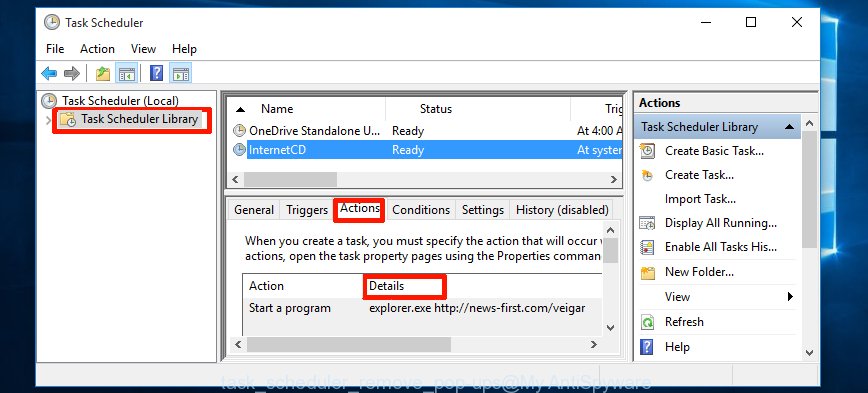
Task scheduler, list of tasks
In the middle part you will see a list of installed tasks. Select the first task, its properties will be show just below automatically. Next, click the Actions tab. Necessary to look at the text which is written under Details. Found something such as “explorer.exe http://site.address” or “chrome.exe http://site.address” or “firefox.exe http://site.address”, then you need remove this task. If you are not sure that executes the task, then google it. If it’s a component of the ‘ad-supported’ apps, then this task also should be removed.
Further click on it with the right mouse button and select Delete as shown on the image below.

Task scheduler, delete a task
Repeat this step, if you have found a few tasks that have been created by adware. Once is finished, close the Task Scheduler window.
Run free malware removal utilities to completely get rid of “Critical Firefox Update” fake alerts
Manual removal is not always as effective as you might think. Often, even the most experienced users may not completely remove ad supported software which causes misleading “Critical Firefox Update” popup scam on your browser. So, we recommend to scan your computer for any remaining malicious components with free adware removal software below.
Automatically get rid of “Critical Firefox Update” popup with Zemana Anti-malware
Zemana Anti-malware highly recommended, because it can search for security threats such ad supported software and adwares that most ‘classic’ antivirus software fail to pick up on. Moreover, if you have any “Critical Firefox Update” pop up scam removal problems which cannot be fixed by this tool automatically, then Zemana Anti-malware provides 24X7 online assistance from the highly experienced support staff.

- Please go to the following link to download Zemana Free. Save it to your Desktop so that you can access the file easily.
Zemana AntiMalware
164813 downloads
Author: Zemana Ltd
Category: Security tools
Update: July 16, 2019
- When the downloading process is finished, close all software and windows on your personal computer. Open a file location. Double-click on the icon that’s named Zemana.AntiMalware.Setup.
- Further, press Next button and follow the prompts.
- Once installation is complete, press the “Scan” button . Zemana Anti-Malware tool will begin scanning the whole computer to find out ad supported software that cause misleading “Critical Firefox Update” fake alerts to appear. This task can take some time, so please be patient. When a threat is detected, the number of the security threats will change accordingly. Wait until the the checking is complete.
- After Zemana Anti Malware has finished scanning your PC, Zemana Anti Malware will open you the results. Review the scan results and then click “Next”. After that process is complete, you can be prompted to restart your system.
Automatically delete “Critical Firefox Update” pop up warnings with Malwarebytes
We suggest using the Malwarebytes Free that are completely clean your machine of the adware. The free tool is an advanced malware removal program made by (c) Malwarebytes lab. This application uses the world’s most popular antimalware technology. It is able to help you get rid of annoying “Critical Firefox Update” pop-up from your web browsers, potentially unwanted programs, malicious software, hijackers, toolbars, ransomware and other security threats from your PC for free.
Download MalwareBytes Free from the link below. Save it on your Windows desktop or in any other place.
327070 downloads
Author: Malwarebytes
Category: Security tools
Update: April 15, 2020
Once the downloading process is done, close all windows on your machine. Further, run the file called mb3-setup. If the “User Account Control” prompt pops up as displayed on the image below, press the “Yes” button.

It will display the “Setup wizard” which will help you set up MalwareBytes Anti Malware (MBAM) on the system. Follow the prompts and don’t make any changes to default settings.

Once installation is finished successfully, click Finish button. Then MalwareBytes Free will automatically run and you can see its main window as displayed in the following example.
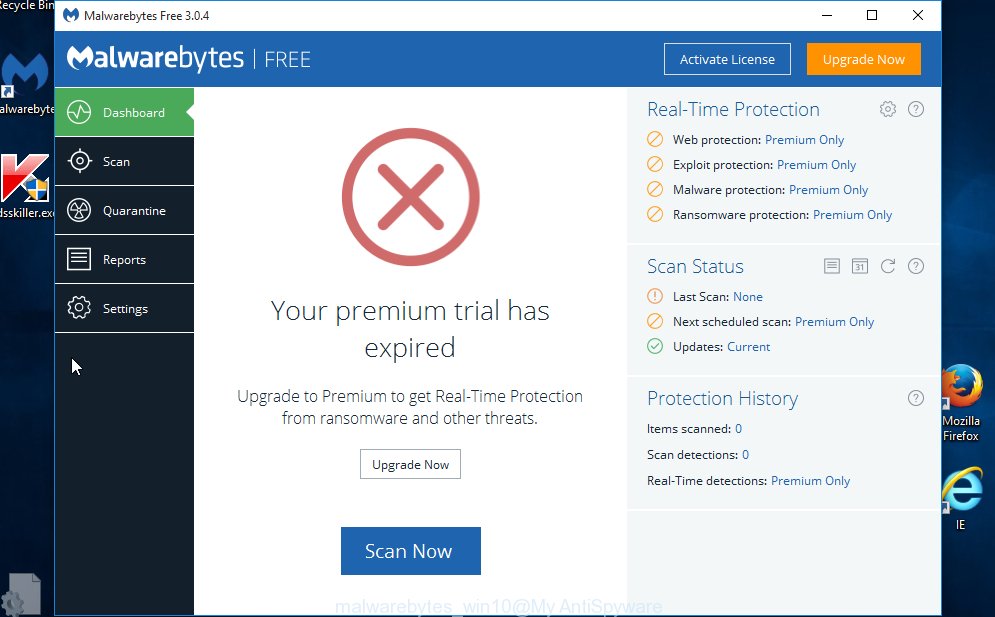
Next, click the “Scan Now” button . MalwareBytes Free utility will start scanning the whole machine to find out ‘ad supported’ software which causes misleading “Critical Firefox Update” popup on your web-browser. This task can take some time, so please be patient. When a malicious software, adware or PUPs are found, the count of the security threats will change accordingly. Wait until the the scanning is done.
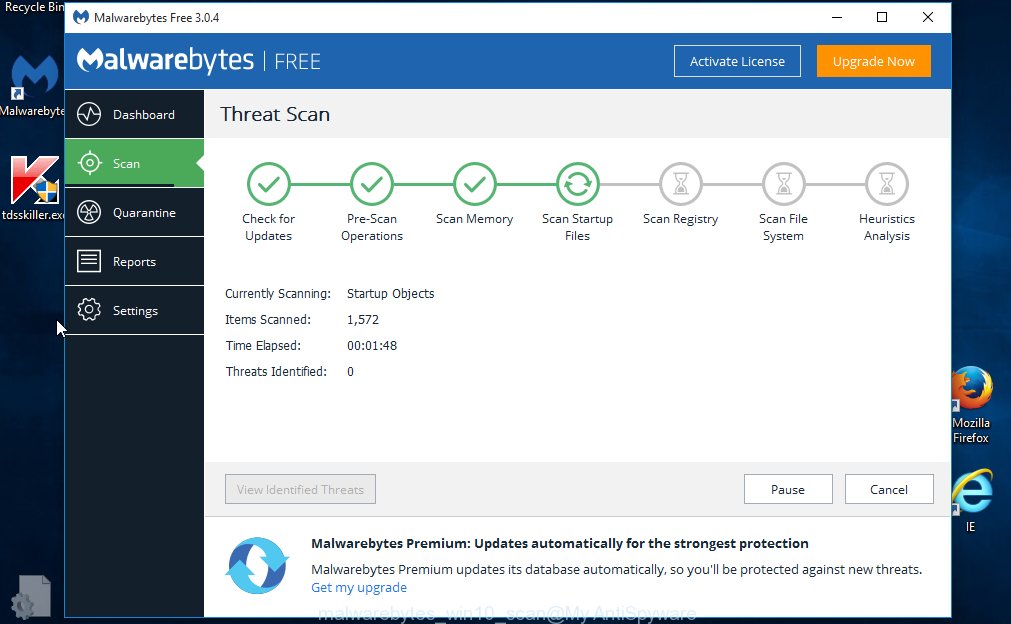
After MalwareBytes completes the scan, you’ll be shown the list of all found items on your computer. You may move threats to Quarantine (all selected by default) by simply click “Quarantine Selected” button.

The MalwareBytes AntiMalware (MBAM) will remove adware which displays misleading “Critical Firefox Update” popup on your PC and move items to the program’s quarantine. Once the clean-up is finished, you can be prompted to restart your computer. We recommend you look at the following video, which completely explains the procedure of using the MalwareBytes Anti Malware to remove hijackers, ad supported software and other malware.
Remove “Critical Firefox Update” fake alerts from browsers with AdwCleaner
AdwCleaner is a free portable application that scans your computer for adware that developed to show misleading “Critical Firefox Update” pop-up warnings within your web-browser, PUPs and hijacker infections and helps remove them easily. Moreover, it will also help you remove any harmful internet browser extensions and add-ons.
Please go to the link below to download AdwCleaner. Save it on your Desktop.
225545 downloads
Version: 8.4.1
Author: Xplode, MalwareBytes
Category: Security tools
Update: October 5, 2024
When downloading is done, open the folder in which you saved it and double-click the AdwCleaner icon. It will launch the AdwCleaner utility and you will see a screen as on the image below. If the User Account Control prompt will ask you want to start the application, press Yes button to continue.
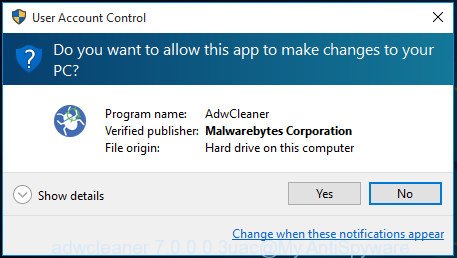
Next, press “Scan” to perform a system scan for the adware that causes multiple misleading “Critical Firefox Update” alerts and pop ups. A scan may take anywhere from 10 to 30 minutes, depending on the number of files on your PC system and the speed of your PC. During the scan AdwCleaner will find threats present on your personal computer.
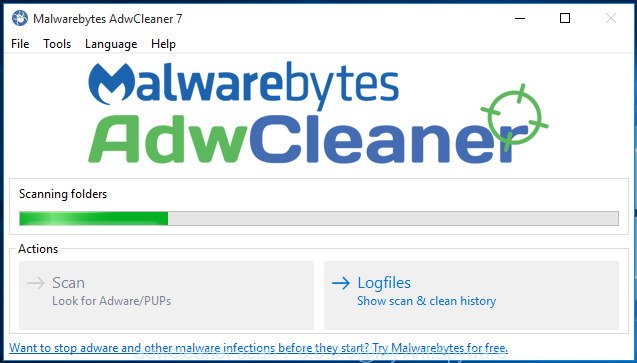
When the scan get completed, AdwCleaner will open you the results as displayed in the following example.
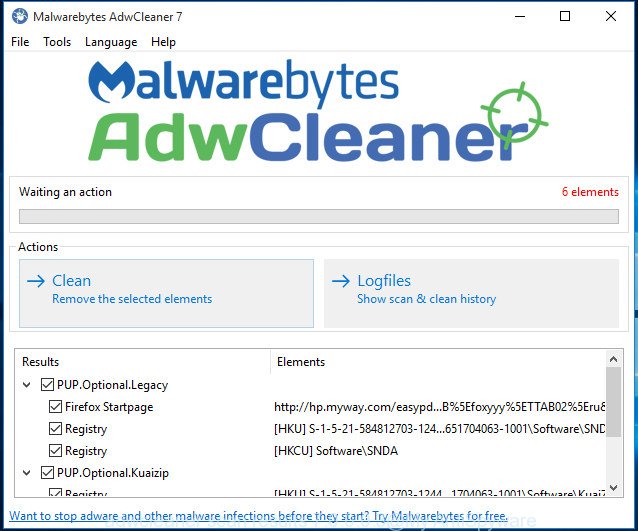
When you’re ready, click “Clean” button. It will show a prompt. Click “OK” button. The AdwCleaner will remove adware that causes misleading “Critical Firefox Update” fake alerts on your internet browser and move items to the program’s quarantine. When the procedure is done, the tool may ask you to restart your PC system. After restart, the AdwCleaner will open the log file.
All the above steps are shown in detail in the following video instructions.
Use AdBlocker to block “Critical Firefox Update” and stay safe online
Run an ad-blocking tool such as AdGuard will protect you from harmful advertisements and content. Moreover, you can find that the AdGuard have an option to protect your privacy and stop phishing and spam web-pages. Additionally, ad blocker apps will allow you to avoid undesired pop-ups and unverified links that also a good way to stay safe online.
Download AdGuard program from the following link. Save it to your Desktop so that you can access the file easily.
26842 downloads
Version: 6.4
Author: © Adguard
Category: Security tools
Update: November 15, 2018
Once the downloading process is finished, start the downloaded file. You will see the “Setup Wizard” screen as displayed on the screen below.

Follow the prompts. Once the install is finished, you will see a window as shown in the following example.

You can press “Skip” to close the installation program and use the default settings, or click “Get Started” button to see an quick tutorial that will allow you get to know AdGuard better.
In most cases, the default settings are enough and you do not need to change anything. Each time, when you run your system, AdGuard will start automatically and block pop up ads, Critical Firefox Update fake alerts, as well as other harmful or misleading web pages. For an overview of all the features of the application, or to change its settings you can simply double-click on the AdGuard icon, that is located on your desktop.
Method of “Critical Firefox Update” popup scam intrusion into your personal computer
The adware usually spreads in the composition, together with another program in the same setup package. The risk of this is especially high for the various free applications downloaded from the Net. The authors of the software are hoping that users will run the quick installation option, that is simply to click the Next button, without paying attention to the information on the screen and do not carefully considering every step of the setup procedure. Thus, the ad supported software can infiltrate your PC without your knowledge. Therefore, it is very important to read all the information that tells the program during setup, including the ‘Terms of Use’ and ‘Software license’. Use only the Manual, Custom or Advanced installation option. This method will help you to disable all optional and unwanted apps and components.
Finish words
Now your machine should be clean of the ‘ad supported’ software that cause misleading “Critical Firefox Update” pop up scam to appear. Delete AdwCleaner. We suggest that you keep AdGuard (to help you stop unwanted advertisements and undesired malicious pages) and Zemana Free (to periodically scan your system for new malware, browser hijackers and ad-supported software). Make sure that you have all the Critical Updates recommended for Windows OS. Without regular updates you WILL NOT be protected when new adwares, harmful apps and adware are released.
If you are still having problems while trying to remove “Critical Firefox Update” pop-up scam from your web browser, then ask for help in our Spyware/Malware removal forum.


















